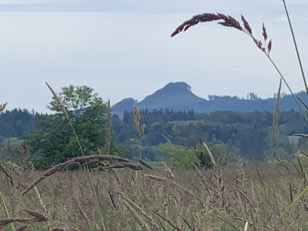Exploring a new place
24/06/20 05:09
I’ve lived most of my life in semi-arid places. Rapid City averages 18 inches of rain per year, most of which falls as snow. This hasn’t been a problem for me. I like the snow. I enjoy winter sports and the cold doesn’t bother me. I have plenty of warm clothing and for my years in Rapid City, I owned snowblowers to help with clearing our somewhat steep driveway. Humans are remarkably adaptable creatures and we can live in a wide variety of different places and climates.
Now we are exploring a place where there is more rain, about 38 inches per year. As the Pacific Northwest goes, it is a fairly dry area. Olympia, the capitol of Washington, receives 53 inches of rain a year. All of that rain produces some dramatic trees. There are forests in Washington, filled with Hemlock, Spruce, and Douglas Fir, where the trees are 150’ tall. Ferns cover the ground. It is very different from the hills, where a Ponderosa Pine or Black Hills Spruce that is 60’ tall is considered to be a big tree.
Still, it is a different kind of climate. Average snowfall in Mount Vernon, Washington is 5 inches per year. Most of the precipitation comes as rain. Today the forecast is for rain showers to come off and on al morning. It doesn’t cramp the style of the locals. They have rain gear and are used to the showers.
The area around the home of our family here has a high water table. There are plenty of houses that are set on block foundations raising them 4 or more feet above the ground level. Our son and his family have a small basement under part of their house, but that kind of construction is fairly rare. Across the road is a field that is flooded part of the year and presently is nearly saturated with water. You don’t have to walk far to find marshes filled with frogs singing and standing water.
It is good country for gardens. Our son and his family have a lot that is roughly the size of the one we have at home, but more than half of it is taken up with gardens. They have berries and fruit trees and flowers and lots of vegetables. They are able to eat from their garden all summer long and they fill a freezer with strawberries and blueberries and raspberries. They have apples and in a few years there will be plums and a lot more apples.

We’ve vacationed here before and while this visit is a scouting trip to explore the possibilities of living here, we haven’t gotten out of the vacation mode yet. Thinking of this place as our home will take some time and some adjustment. Fortunately we have that time. For this week, we are mostly focused on enjoying our grandchildren and exploring the immediate neighborhood.
It is a stretch of my imagination to envision living in this place. We have quite a bit of winter clothing that we might not need here. You don’t see insulated coveralls on the folks around here. On the other hand, they all have good rain gear and workers have waterproof boots that come up nearly to their knees.
Once again, as the region goes, this particular community is not in the wettest part of the state. In fact the average rainfall in Mount Vernon, Washington, is the same as the average rainfall for all of the communities of the United States. People live and thrive in this kind of environment. It is just that we happen to have lived in places with a bit less rain.
The rain contributes to amazingly productive ground. Things grow well here. That is what attracted people to this country for so long. In this county are acres and acres of flowers grown. Growing tulip bulbs for sale is a big business for farmers in this area. It makes for a colorful spring and people form Seattle make day trips to drive up and see the flowers.
I’m pretty sure that we will find other adjustments that are as hard and harder than the change in weather. For now, on a scouting trip, I’m just trying to imagine what it might feel like to move to a new place and adopt a new lifestyle. Time will tell how we adapt, but we know that we will. Change is good for our minds and probably good for our bodies as well. The challenges of a new place are different from those of the place we are leaving behind.
Each day we take a walk. Our son and his family live right on the edge of a small town. Walk in one direction and you can explore the neighborhoods. Walk in the other direction and you are out in the country. We’ve had time to walk in both directions. Exploring the area is part of the fun of the visit. As we walk, I often comment on the houses that we see and speculate about the people who live in them. “That house must be filled with stairways.” “Here is one that is very tiny with a huge shop building.” “That long ramp means someone in that house must use a wheelchair or a walker.” In a couple of months, we’ll begin looking for our next house. The process will be different. I’m going to make sure it isn’t sitting in a puddle. A hill or a little rise might suit me better.
